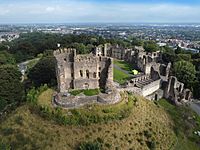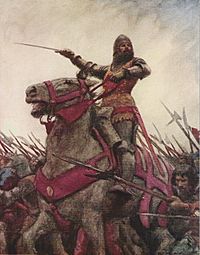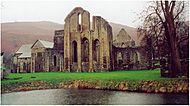House of Mathrafal facts for kids
| House of Mathrafal |
|||
|---|---|---|---|
Quick facts for kids 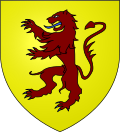 Arms of the Mathrafal House of Powys |
|||
| Country: | Wales | ||
| Parent House: | House of Dinefwr | ||
| Titles: | *King of Wales
|
||
| Founder: | Bleddyn ap Cynfyn, King of Gwynedd and Powys | ||
| Founding Year: | 1063 | ||
| Cadet Branches: | *House of Corsygedol | ||
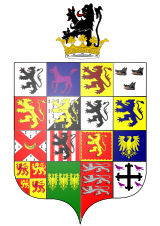

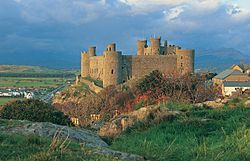
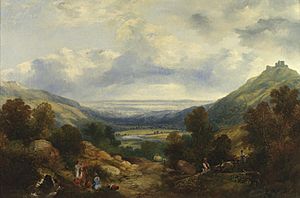
The Royal House of Mathrafal began as a cadet branch of the Welsh Royal House of Dinefwr, taking their name from Mathrafal Castle, their principal seat and effective capital. They effectively replaced the House of Gwertherion, who had been ruling the Kingdom of Powys since late Roman Britain, through the politically advantageous marriage of an ancestor, Merfyn the Oppressor. King Bleddyn ap Cynfyn would join the resistance of the Anglo-Saxon King Harold Godwinson, against the invasion of William the Conqueror, following the Norman conquest of England. Thereafter, they would struggle with the Plantagenets and the remaining Welsh Royal houses for the control of Wales. Although their fortunes rose and fell over the generations, they are primarily remembered as Kings of Powys and last native Prince of Wales.
History

The House of Mathrafal was effectively established in the wake of the Anglo-Saxon King, Harold Godwinson, and his brother, Tostig Godwinson, Earl of Northumbria, and their disastrous raids of 1062–1063 against the King of Wales, Gruffydd ap Llywelyn. They installed Bleddyn ap Cynfyn as King over Powys and Gwynedd and kept him and his base in Mathrafal close to the Saxon border. Mathrafal Castle became their seat and effective capital in Powys, replacing the Roman city of Viroconium.
From this point forward, his family jockeyed with the Royal House of Dinefwr and the Royal House of Aberffraw for the control of Wales. (The unrelated dynasty in the Kingdom of Gwent and the Kingdom of Morgannwg was swiftly overrun by the Marcher Lords after the Norman Conquest).
The House of Mathrafal's influence was greatest between 1063 and 1081, until they lost control of Gwynedd to a resurgent Aberffraw family following the Battle of Mynydd Carn. By 1191, the Kingdom of Powys was divided between the Principality of Powys Fadog in the north and the Principality of Powys Wenwynwyn (roughly modern Montgomeryshire) in the south. The first became a more-or-less loyal vassal of Gwynedd; the latter, one of its main competitors.
Historian John Davies points out that, following the division of Powys, the dynasty should not be considered as "equal" to that of the Royal House of Aberffraw or the Royal House of Dinefwr. Mathrafal Castle was utterly destroyed by Gwynedd in 1212 and thenceforth it was entirely dependent on English support for its survival. However, the Mathrafal dynasty continued to exert some influence, undermining and eventually betraying the Prince of Wales, Llywelyn ap Gruffudd, on behalf of the Plantagenet King, Edward Longshanks, during his Conquest of Wales in 1282–83.
Thereafter, they avoided his campaign of extermination against the Welsh Royal Houses and even exchanged their claims to royalty for an English Lordship at the Parliament of Shrewsbury in 1283. They were displaced by the Lords of Mortimers in the early 14th century, until a momentary reascension of the House during the 15th century, following the Welsh Revolt led by the Prince of Wales, Owain Glyndŵr, against Prince Henry and King Henry IV of England, of the Royal House of Lancaster. Glyndwr combined the claims of the Houses of Mathrafal and Dinefwr, with links to the House of Aberffraw.
Welsh Revolt
The rebellions were supported by the French Royal House of Valois, and were an attempt not only at gaining the independence of Wales, but also the redivision of England to their relatives, the House of Percy and the Mortimers. Despite being crowned as Owain IV of Wales in 1404, and having taking control of all Wales, and having created the first Welsh parliament at Harlech Castle, they eventually lost the war to the English forces of Henry IV and Henry V.
Nonetheless, their efforts didn't go in vain, as their rebellion gave rise to the first Welsh Kings of England, the Royal House of Tudor. The Tudors were their cousins on their mother's side, through the Tudors of Penmynydd, who fought with them during the rebellions, such a Sir Owen Tudor, the second husband of Queen Catherine of France. Glyndŵr was also the wealthiest Welshman in Wales before his downfall in 1415, and captured number of Longshanks’s main castles such as Conwy, Harlech and Beaumaris, and besieged Caernarfon.
This historic period would later be immortalized by William Shakespeare in his play Henry IV, Part 1 and Part 2, featuring "Owen Glendower" as a character. The plays depict the wars between his family and Prince Hal, future Henry V, and other historical events. Other characters featured include his daughter, Lady Mortimer, his son-in-law, Sir Edmund Mortimer, and in-laws Henry Hotspur Percy and Lady Percy. The plays were succeeded by "Henry V'" and are part of Shakespeare's Henriad.
Succession
The House was succeeded by the descendants of prince Owain Glyndŵr and his brother, lord Tudur ap Gruffudd, through the Vaughans of Cors-y-Gedol. They are today represented by its derivative branches; the House of Yale (Yale family) and the Rogers of Bryntangor, who act as co-representatives of the dynasty. They are also the co-representatives of the Sovereign dynasties of North Wales (Gwynedd) and South Wales (Dinefwr), having their genealogies traced back to the Romano-British ruler Cunedda.
The Vaughans, Yales, and Hughes of Gwerclas, are also cadet branches of the FitzGerald Dynasty, and direct descendants of the Plantagenets. Their ancestor, lord Gerald de Windsor, was an Anglo-Norman, son of the 1st governor of Windsor Castle for William the Conqueror, and ancestor of the current Duke of Leinster in Ireland. Notably, he married a Welsh princess named Nesta, daughter of king Rhys ap Tudor, of the House of Dinefwr.
The Wynn baronets, who are today represented by the Williams-Wynns, are related to Mathrafal through the princes of Aberffraw and the Wynne family of Peniarth, and the Jones of Faerdref Uchaf through the Hughes of Gwerclas. A descendant, Mary Wynn, daughter of the 4th Baronet, married Robert Bertie, 1st Duke of Ancaster of Grimsthorpe Castle, and passed the Wynnstay Estate to her cousin, Sir John Wynn, 5th Baronet.
Members
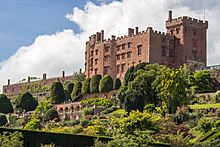
Members of the Mathrafal Dynasty include:
- Bleddyn ap Cynfyn, King of Powys and Gwynedd, joined the Anglo-Saxon resistance with King Harold Godwinson, of the Royal House of Godwin, against William the Conqueror
- Gruffydd ap Llywelyn, King of Wales, son-in-law of Ælfgar, Earl of Mercia, Lady Godiva's son, made an agreement with King Edward the Confessor, of the Royal House of Wessex, his widow remarried the last Anglo-Saxon king Harold Godwinson, who died at Hastings fighting against William the Conqueror
- Rhiwallon ap Cynfyn, King of Powys and Gwynedd, his daughter married the King of Deheubarth, Rhys ap Tewdwr, of the Royal House of Dinefwr, was half-brother of the King of Wales Gruffydd ap Llywelyn
- Trahaearn ap Caradog, King of Gwynedd, fought against the King of the Welsh, Gruffudd ap Cynan, of the Royal House of Aberffraw, and the Norman Lord Robert of Rhuddlan
- Rhiryd ap Bleddyn, King of Powys, killed at war by the King of South Wales, Rhys ap Tewdwr, of the Royal House of Dinefwr, his father King Bleddyn ap Cynfyn was the founder of Mathrafal
- Cadwgan ap Bleddyn, Prince of Powys, married to a member of the House of De Say, companions of William the Conqueror, was an ally of King Gruffudd ap Cynan against the Montgomeries, Norman magnates
- Owain ap Cadwgan, Prince of Powys, he and his father lost lands to King Henry I of England, was known for his abduction of Princess Nest, wife of Gerald de Windsor, of the House of FitzGerald
- Iorwerth ap Bleddyn, Prince of Powys, joined the rebellions of Robert of Bellême, 3rd Earl of Shrewsbury, of the House of Bellême, then betrayed him with Lord William Pantulf
- Maredudd ap Bleddyn, Prince, later King of Powys, made peace with King Henry I of England, of the Royal House of Normandy, is featured in Brut y Tywysogion and retired to Snowdonia
- Gruffydd Fychan ap Iorwerth, Marcher Lord, Knight of Rhodes and Knight of the Order of Saint John of Jerusalem, fought in the Crusades under the Knights Hospitaller, rivals of the Knights Templar, his military order was under the protection of Frederick Barbarossa, Holy Roman Emperor
- Gwladys ferch Rhiwallon, Queen of Deheubarth, and mother of Princess Nesta, who had a son with King Henry I of England, son of William the Conqueror
Last Prince of Powys

- Madog ap Maredudd, Prince of Powys, fought with Ranulf de Gernon, 4th Earl of Chester of Lincoln Castle, for the Holy Roman Empress Matilda, against the King of England, Stephen of Blois, of the Royal House of Blois
- Gruffydd Maelor I, Prince of Powys Fadog, Lord of Yale, married to Princess Angharad, daughter of the 1st Prince of Wales, Owain Gwynedd, of the Royal House of Aberffraw
- Madog ap Gruffydd Maelor, his son, Prince of Powys Fadog, bore the Black Lion, built the religious center of Valle Crucis Abbey in the lordship of Yale, was grandson of the 1st Prince of Wales, Owain Gwynedd, cousin of Prince Llywelyn ab Iorwerth, and ally of King John Plantagenet of Magna Carta
- Owain Fychan, Lord of Mechain Is Coed, captured Carreghofa Castle, lost it to King Henry II of England, of the Royal House of Angevin, then took it back
- Owain Brogyntyn, Lord of Edeirnion, Lord of Dinmael, of Castle Brogyntyn, confirmed Baron by King Edward Longshanks, of the Royal House of Plantagenet, under the terms of the Statute of Rhuddlan
- Marared ferch Madog, mother of the Prince of North Wales and Lord of Snowdonia, Llywelyn the Great, and was married to Iorwerth ab Owain Gwynedd, of the Royal House of Aberffraw
- Efa ferch Madog, married to the Prince of Maelienydd, Cadwallon ap Madog, the great-grandson of the Prince of Buellt, who founded one of the Five Royal Tribes of Wales
- Gwenllian ferch Madog, daughter of Prince Madog ap Maredudd, ancestress of the Tudors, was married to Lord Rhys, Prince of Wales, who fought and captured many castles of Richard the Lion Heart
- Gwenwynwyn ab Owain Cyfeiliog, Ruler of Mid Wales, made an agreement with King Richard the Lionheart, of the Royal House of Plantagenet
- Gruffydd ap Gwenwynwyn, Welsh King and Prince of Powys Wenwynwyn, married to Hawise, daughter of Marcher Lord John Lestrange, whose father John II joined the Third Crusade against Saladin
- Owen de la Pole, Lord of Powys, family lost their Principality to King Edward Longshanks during his Conquest of Wales, his aunt was Lady Isabella, Queen of Cyprus of the House of Ibelin, and great-great-granddaughter of Balian of Ibelin, who famously defended and surrendered Jerusalem to Saladin
- Hawys Gadarn, mother of Lord Charlton, he was married to a daughter of Roger Mortimer, 1st Earl of March, who was the great-grandson of John of Brienne, King of Jerusalem and Emperor of Constantinople
- Griffith de la Pole, Lord of Powys, was the uncle of Lord Charlton, who was married to a granddaughter of Joan of Lusignan, member of the Royal House of Lusignan
- John Charlton, 3rd Baron Charlton, married to a daughter of the Earl of Stafford, his family included the Duke of Buckingham, Lancaster, Gloucester, and Bavaria of the Royal House of Wittelsbach
- Gruffudd Fychan I, Prince of Powys Faddog, Lord of Yale, Edeirnion and Glyndyfrdwy, great-grandfather of Prince Owain Glyndŵr and Lord Tudor Glendower, lost the Lordship of Bromfield and Yale to the Guardian of Scotland, John de Warenne, the Commander defeated by William Wallace at the Battle of Stirling Bridge
- Gruffudd Fychan II, Prince of Powys Fadog, married to a great-granddaughter of Eleanor Plantagenet, the daughter of King Edward I and Queen Eleanor of Castile of the Royal House of Ivrea
- Eleanor ap Thomas, wife of Prince Gruffudd Fychan II, father was Lord of South Wales, her cousins and in-laws included the Royal houses of Habsburg, Gonzaga, Lorraine, Valois, and Savoy
- Owain Glyndŵr, Prince of Wales, hereditary Prince of Powys Fadog, married to Princess Margaret Hanmer, daughter of Sir David Hanmer, started the Welsh Revolt, was the wealthiest Welshman in Wales
- Tudor Glendower, Lord of Gwyddelwern, brother of the Prince of Wales and cousin of the Tudors, fought against Prince Henry, of the Royal House of Lancaster, during the Welsh Revolt
- Lowry ap Gruffudd, his sister, was married to Robert Puleston, their son held Denbigh Castle for his cousin Jasper Tudor, Duke of Bedford, of the Royal House of Tudor, during the Wars of the Roses
- John Charlton, 4th Baron Charlton, family included Duchess Elizabeth FitzAlan, ancestress of Queen Anne Boleyn, and Beatrice, daughter of King John I of Portugal of the Royal House of Aviz
- Edward Charlton, 5th Baron Charlton, married to Alianore Holland, in-law of Lord Visconti of Milan, niece of King Richard II, great-grandmother of King Edward IV and Richard III, of the Royal House of York
- Maredudd ab Owain Glyndŵr, son of the Prince of Wales, fought in the Welsh Revolt, was later pardoned by King Henry V of England, of the Royal House of Lancaster
- Catrin ferch Owain Glyndŵr, married to Sir Edmund Mortimer, great-nephew of Prince John of Gaunt, Duke of Lancaster, and Edward the Black Prince, cousin of King Henry IV of England, and great-grandson of King Edward of Windsor and Queen Philippa of Hainault
- Lowrie ap Tudur, heiress of her father Lord Tudor Glendower, and uncle Owain Glyndŵr, Prince of Wales, inherited the co-representation of the Sovereign dynasties of Powys (Mathrafal), North Wales (Gwynedd) and South Wales (Dinefwr), married Griffith ap Einion of the Fitzgerald dynasty of Corsygedol
- Elissau ap Gruffudd (Ellis ap Griffith), her son, Baron of Gwyddelwern, grandson of Lord Tudor Glendower, heir by marriage of Allt Llwyn Dragon (renamed Plas-yn-Yale), founder of the House of Yale, grandfather of Chancellor Thomas Yale and great-grandfather of Chancellor David Yale, the great-grandfather of Gov. Elihu Yale, benefactor of Yale University


